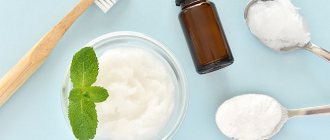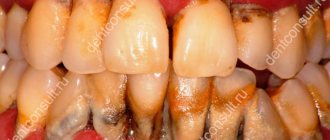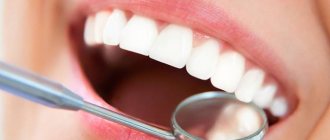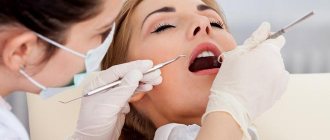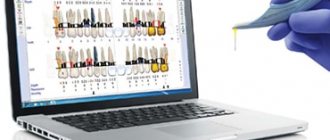2417
Most people want to have beautiful white teeth. However, not everyone has the opportunity or desire to periodically visit a dental clinic for a whitening procedure.
And some even believe that it is worth trying home techniques first before using the services of a professional.
One of the most famous ways to whiten enamel with home remedies is lemon .
There are many recipes that tell you exactly how to use this fruit to lighten your teeth enamel. In this article we will take a detailed look at not only possible techniques and recipes, but also talk about their positive and negative sides.
Pros and cons of the procedure
Like most home whitening techniques, using lemon for this purpose has its positive and negative sides.
Advantages:
- An important advantage of the technique is its accessibility and low cost , even compared to other home whitening products.
- Effectively whitens tooth enamel , giving it a lighter shade.
- During the procedure, the mucous membranes of the oral cavity are also disinfected , which gets rid of germs and helps prevent caries.
- The use of this fruit improves immunity (including local immunity).
- Gives fresh breath without the use of artificial mouthwashes.
- Lemon juice helps reduce toothache .
The vast majority of people can use this whitening product, which makes it universal. The exception is patients who are allergic to this fruit.
Flaws:
The method has practically no disadvantages. One has only to say that the acid in lemon juice can have a negative effect on the structure of the enamel, so it should be used very carefully .
How to use Blik pencil to whiten teeth? Features and recommendations.
In this review, read about the benefits and effectiveness of Splat black toothpaste.
Here https://www.vash-dentist.ru/krasota-i-uxod/otbelivanie/zubov-s-pomoshhyu-perekisi-vodoroda-metodiki-i-otzyivyi.html we will discuss how safe the whitening procedure using hydrogen peroxide is.
How to whiten teeth
Conventionally, all lightening methods can be classified into:
- professional (performed by a doctor);
- non-professional (they are also home-made).
The first include:
- photobleaching;
- laser;
- chemical;
- endobleaching;
- homemade using individual caps.
Each of these methods has its own advantages and disadvantages.
When talking about the second - unprofessional - methods, doctors mean:
- the use of pharmaceutical pastes, pencils, strips containing lightening components;
- wearing universal mouthguards purchased without a dentist’s prescription.
Unprofessional methods cannot be called safe. Their uncontrolled use often results in a significant increase in sensitivity and the development of other negative complications. The exception is brushing your teeth with a whitening paste selected by your dentist. But it is permissible to use such a composition strictly in courses, and not on an ongoing basis.
Technique
Homemade variations on the use of lemon's teeth-lightening properties are numerous. However, they all have several common nuances . In order not to repeat ourselves in each recipe, we will talk about them separately:
- Before each procedure, as well as for some time after it, you should not eat foods containing strong dyes , for example, beets, red wine, strong tea (both black and green), coffee and others.
- Also, before starting the procedure, you should brush your teeth well using your usual brush and toothpaste.
By following these tips, you can make whitening more effective .
One-ingredient recipes
These are quite strong techniques, so their use is not recommended more than once every 7-10 days. The number of procedures is no more than four.
Rubbing with a slice
You need to cut a thin slice from a fresh fruit.
It needs to be rubbed onto the surface of the enamel and not washed off for several minutes . Depending on the degree of darkening and the individual characteristics of each patient’s teeth, the exposure time may vary.
For greater effectiveness, do not close your mouth tightly while waiting for the effect .
After the effect becomes noticeable externally (usually this should wait about 5 minutes, sometimes longer), the remaining lemon should be washed off well without using paste or other artificial products.
Rubbing with zest
This method is considered more gentle than the first, since the zest contains slightly less acid than the pulp itself.
The fruit should be peeled so that large enough pieces remain. The lemon itself can be used in any way you like, since to lighten the enamel you only need the zest .
The outer side of each tooth must be thoroughly rubbed with a piece of peel, using its inner side . After that, leave your mouth open for a few minutes (but no more than 3-5) for free access of air.
Usually this is enough for a visual effect - the enamel becomes lighter during the procedure. Next, you should rinse your mouth.
Pulp lotions
The method is suitable for those people whose teeth darken quite strongly, but at the same time the enamel is quite thick and strong.
You need to make a paste from the seedless lemon pulp and dense inner films. It is applied to the surface of the teeth and held for up to five minutes, leaving the mouth slightly open, as in previous recipes.
After the procedure, the pulp should be washed off by rinsing, but not with a toothbrush .
The easiest way
It consists of chewing a piece of lemon pulp for 2-3 minutes .
The effect of this procedure will also be quite noticeable. However, the disadvantage of the technique is that when chewing, the surfaces of different teeth are exposed to different degrees to citric acid .
For better penetration into hard-to-reach places, as well as to simultaneously reduce the negative effects of citric acid, patients with hypersensitivity can chew not the pulp, but a piece of zest .
To learn about the effectiveness of another recipe, watch the video:
Possible complications after whitening
The procedure has a fairly strong effect on the external dental structures, so sometimes negative side effects occur after it is performed. The most common is hypersensitivity. Then the patient complains of the inability to eat sour, sweet, and hot foods. Even trying to eat a portion of ice cream causes him unbearable pain.
To avoid the problem, you need to carry out remineralization. During this procedure, the teeth are treated with a strengthening compound. This will neutralize the pain after bleaching.
Sometimes after therapy, fillings begin to fall out. But this only happens with old restorations that should have been replaced a long time ago. If this happens, you should immediately sign up for caries treatment.
With additives
Milder whitening methods , which can be used 1-2 times a week for 1.5-2 months.
Simple rinses
For whitening rinses, use a solution that is prepared from clean water at room temperature and fresh lemon juice in a one-to-one ratio . For one procedure, a small amount of solution is enough - about 100 ml.
You need to rinse thoroughly so that the effect of the acid also extends to the interdental spaces and gingival grooves. After all, it is in these areas that dental plaque accumulates, which is much darker than other surfaces.
Pasta with juice
This method can be used by people who have increased tooth sensitivity or other unpleasant phenomena.
It consists of brushing your teeth with your usual toothpaste, enriched with a few drops of lemon juice . This paste is prepared anew for each procedure.
Both options for its preparation are equally effective :
- In the first case, which is more complex, a small amount of paste, sufficient for cleaning, is thoroughly mixed separately with 5-6 drops of freshly squeezed juice.
- The second option is simpler - just place the paste directly on the brush and add a few drops of juice on top.
Complex pasta
Here another ingredient is added - activated carbon .
To prepare a bleaching agent, you need to crush one charcoal tablet and mix it with a small amount of paste. After mixing, add 5-7 drops of lemon juice.
Use this product to brush your teeth according to the usual procedure, but no more than twice a week .
Coal acts as an abrasive, effectively removing solid particles of plaque, and also as an absorbent - absorbing various dyes and pigment substances.
It is recommended to use once every few days, preferably at night, to prevent food from affecting the enamel.
With soda
There are also various options for preparing a bleaching agent and directly carrying out the procedure itself .
Soda is used in all cases as an excellent abrasive, which allows you not only to whiten the enamel, but also to remove the hard coating that forms on it:
- The first method is to add 5-7 drops of squeezed lemon juice to 1/3 teaspoon of baking soda, mix thoroughly and rub the teeth with this mixture using gauze or a brush.
- The second method is to first wipe the surface with juice or apply chopped pulp for a few minutes, and then clean it with soda.
- The third method is to prepare a mixture of soda (0.5 teaspoon), juice (5-7 drops) and 3% hydrogen peroxide solution.
The composition is applied to the enamel (this can be done both on the outer and inner surfaces) using a piece of gauze or cotton wool. However, you should not rub it too hard. Wash off with warm water 10–15 minutes after application. - The fourth method is to mix one teaspoon of soda and vinegar with 10 drops of juice, sometimes also adding salt. The composition is used to wipe the enamel with gauze.
Unprofessional whitening
Systems sold online and in beauty stores should be used at your own risk. Dentists do not recommend buying such developments. The best ones are those that contain hydrogen peroxide or carbamide. All the others are not able to whiten the enamel, but only provide a good cleansing effect by removing plaque and temporarily leveling the treated surface.
Using non-professional techniques, it is impossible to predict the outcome of therapy. For some people it turns out to be positive, for others it is neutral or negative. Here a lot depends on the original color. When visiting a dental clinic, the result is always predictable, and the patient knows what to expect. Any risks are minimized.
Use of "derivatives"
is suitable for whitening , but also its various components and derivatives .
Oil
After normal daily hygiene procedures, you can rinse with a special composition that contains lemon essential oil. According to reviews, this method gives a clearly visible effect only with long-term use , however, it is the most gentle procedure of all possible.
To prepare a solution for rinsing, you need to add 5-7 drops of lemon oil to a glass of lukewarm water and mix well. Additionally, you can also use tea tree oil, which has a bactericidal effect.
Read how Lakalut whitening toothpaste works in the next publication.
In a separate article we will talk about ways to lighten enamel using activated carbon.
At the link https://www.vash-dentist.ru/krasota-i-uxod/otbelivanie/lazernoe/zubov-zoom-3-opisanie-protseduryi-i-otzyivyi-o-ney.html we will talk about what it is - Zoom 3 and how it differs from previously used teeth whitening technologies.
Food grade citric acid
Instead of fresh fruit, you can also use citric acid, which is used in cooking.
One of the best recipes using it is to brush your teeth with a paste, sprinkled with a pinch of salt and a few crystals of acid on top. You can pre-mix all the ingredients - this way the effect will be softer and have good effectiveness .
Precautionary measures
You should know that teeth whitening with lemon is relatively rare. Frequent use of the product exposes the enamel to the aggressive effects of citric acid, which can weaken it.
Also, after each procedure, you should thoroughly rinse your mouth with warm, clean water after a short time . Sometimes soda is added to it, which, being an alkali, reacts with the acid, neutralizing its residues.
If you find an error, please select a piece of text and press Ctrl+Enter.
Tags at home lemon teeth whitening recipes care teeth cleaning
Did you like the article? stay tuned
Previous article
Treatment Methods for Gum Recession
Next article
Why do my teeth hurt more often at night?

